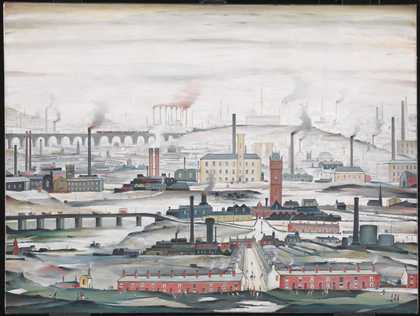
L.S. Lowry
Industrial Landscape (1955)
Tate
A little known painting by LS Lowry (1887-1976) sheds new light on works included in Lowry and the Painting of Modern Life, a major exhibition of urban landscapes by the artist at Tate Britain from 26 June. The exhibition is the first to be held by a public institution in London since the artist’s death in 1976. It is also the first to explore Lowry’s connections with French art, arguing for his status as Britain’s pre-eminent painter of the industrial city.
The unnamed painting, which depicts a crowded town square set against Lowry’s distinctive backdrop of industrial Salford, appears on the back of the wooden panel on which Lowry painted The Mission Room 1937. Tate has discovered that it is an earlier version of two works featured in the exhibition: Our Town 1941 and A Town Square 1928. The latter was exhibited in Paris and reproduced in a biographical French dictionary of contemporary artists in 1931. Lowry’s inclusion in this publication highlights his status in France as a notable British artist who at the time was exhibiting more frequently in Paris than in London.
The newly established link between the unrecorded work and the later versions dramatises how frequently Lowry revisited, refined and developed favourite scenes over many years. On loan from Leamington Spa Art Gallery & Museum, the reverse of the painting has never been displayed outside of the museum.
The exhibition of over 90 works includes Tate’s own pictures Coming Out of School 1927, The Pond 1950, Industrial Landscape 1955 and Hillside in Wales 1962, and significant loans from public and private lenders. It demonstrates Lowry’s uniqueness as a modern British artist who recognised what the industrial revolution had made of the world and devoted his career to this rich and varied subject matter. Without Lowry’s pictures of football and cricket matches, protest marches, funfairs, evictions, arguments, prayer meetings, accidents and workers going to and from the mill, Britain would lack an account in paint of the experiences of the working class in the 20th century.
Exhibition highlights include Ancoats Hospital Outpatients Hall 1952, painted in the early years of the NHS, shown beside an earlier street scene, The Cripples 1949, which shows those disabled by war and illness. Images of London, to which Lowry was a regular visitor, include Piccadilly Circus, London 1960. Excavating in Manchester 1932 depicts a rare scene of men at work building the foundations for one of the last cotton warehouses to be erected in Manchester. Industrial Landscape, Wigan 1925 could be an illustration to George Orwell’s The Road to Wigan Pier 1937; both text and image present apocalyptic scenes of polluted canals and derelict buildings.
The talented late French impressionist, Adolphe Valette, taught Lowry in Manchester for many years and introduced him to impressionism. Lowry’s work is shown alongside that of Vincent van Gogh, Camille Pissarro, Georges Seurat, Adolphe Valette and Maurice Utrillo, highlighting how Lowry drew from and extended the French tradition in his engagement with the life of the city, while establishing his own unique style. Many of his works depict nearby Salford and Pendlebury where Lowry lived and worked.
Significantly the final room of the show brings together, for the first time, the artist’s seven strikingly large urban panoramas of composite northern industrial landscapes and the mining valleys of South Wales. Painted in the 1950s and 60s, these final works make an unexpected leap up in size. Made at the height of his career, they poignantly record the rapid disappearance of the industrial world.
The exhibition is co-curated by TJ Clark and Anne M Wagner, emeritus professors of art history at the University of California, working with Helen Little, Assistant Curator, Tate Britain. The accompanying book, Lowry and the Painting of Modern Life is published by Tate Publishing, 2013.
Lowry and the Painting of Modern Life
Tate Britain, 26 June – 20 October 2013
Supported by The Lowry Exhibition Supporters Group
Open daily 10.00 – 18.00 & Friday – Sunday until 20.00
For public information print 020 7887 8888
tate.org.uk facebook.com/tategallery Twitter @tate #Lowry #TateTour
